Yamaha YDP-101 User Manual

ENGLISH
DEUTSCH
FRANÇAIS
ESPAÑOL
IMPORTANT
Check your power supply
Make sure that your local AC mains voltage matches the voltage specified on the name plate on the bottom panel. In some areas a voltage selector may be provided on the bottom panel of the main keyboard unit near the power cord. Make sure that the voltage selector is set for the voltage in your area. The voltage selector is set at 240V when the unit is initially shipped. To change the setting use a “minus” screwdriver to rotate the selector dial so that the correct voltage appears next to the pointer on the panel.
WICHTIG
Überprüfung der Stromversorgung
Vergewissern Sie sich vor dem Anschließen an das Stromnetz, daß die
örtliche Netzspannung den
Betriebsspannungswerten auf dem Typenschild an der Unterseite des Instruments entspricht. In bestimmten Verkaufsgebieten ist das Instrument mit einem Spannungswähler an der Unterseite neben der Netzkabeldurchführung ausgestattet. Falls vorhanden, muß der Spannungswähler auf die örtliche Netzspannung eingestellt werden. Der Spannungswähler wurde werkseitig auf 240 V voreingestellt. Zum Verstellen drehen Sie den
Spannungsregler mit einem Schlitzschraubendreher, bis der Zeiger auf den korrekten Spannungswert weist.
IMPORTANT
Contrôler la source d’alimentation
Vérifiez que la tension spécifiée sur le panneau inférieur correspond à la tension du secteur. Dans certaines régions, l’instrument peut être équipé d’un sélecteur de tension situé sur le panneau inférieur du clavier à proximité du cordon d’alimentation. Vérifiez que ce sélecteur est bien réglé en fonction de la tension secteur de votre région. Le sélecteur de tension est réglé sur 240 V au départ d’usine. Pour modifier ce réglage, utilisez un tournevis à lame plate pour tourner le sélecteur afin de mettre l’indication correspondant à la tension de votre région vis à vis du repère triangulaire situé sur le panneau.
IMPORTANTE
Verifique la alimentación de corriente
Asegúrese de que tensión de alimentación de CA de su área corresponde con la tensión especificada en la placa de características del panel inferior. En algunas zonas puede haberse incorporado un selector de tensión en el panel inferior de la unidad del teclado principal, cerca del cable de alimentación. Asegúrese de que el selector de tensión esté ajustado a la tensión de su área. El selector de tensión se ajusta a 240V cuando la unidad sale de fábrica. Para cambiar el ajuste, emplee un destornillador de cabeza “recta” para girar el selector de modo que aparezca la tensión correcta al lado del indicador del panel.
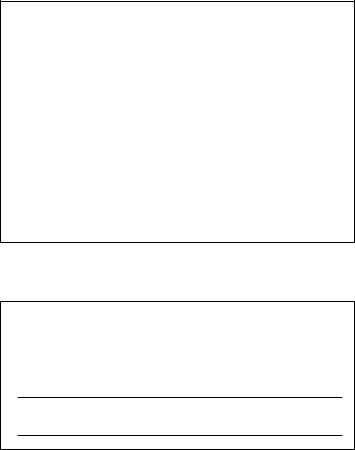
IMPORTANT NOTICE FOR THE UNITED KINGDOM
Connecting the Plug and Cord
IMPORTANT. The wires in this mains lead are coloured in accordance with the following code:
BLUE |
: |
NEUTRAL |
BROWN |
: |
LIVE |
As the colours of the wires in the mains lead of this apparatus may not correspond with the coloured makings identifying the terminals in your plug proceed as follows:
The wire which is coloured BLUE must be connected to the terminal which is marked with the letter N or coloured BLACK.
The wire which is coloured BROWN must be connected to the terminal which is marked with the letter L or coloured RED.
Making sure that neither core is connected to the earth terminal of the three pin plug.
(2 wires)
• This applies only to products distributed by Yamaha-Kemble Music (U.K.) Ltd.
The serial number of this product may be found on the bottom of the unit. You should note this serial number in the space provided below and retain this manual as a permanent record of your purchase to aid identification in the event of theft.
Model No.
Serial No.
(bottom)
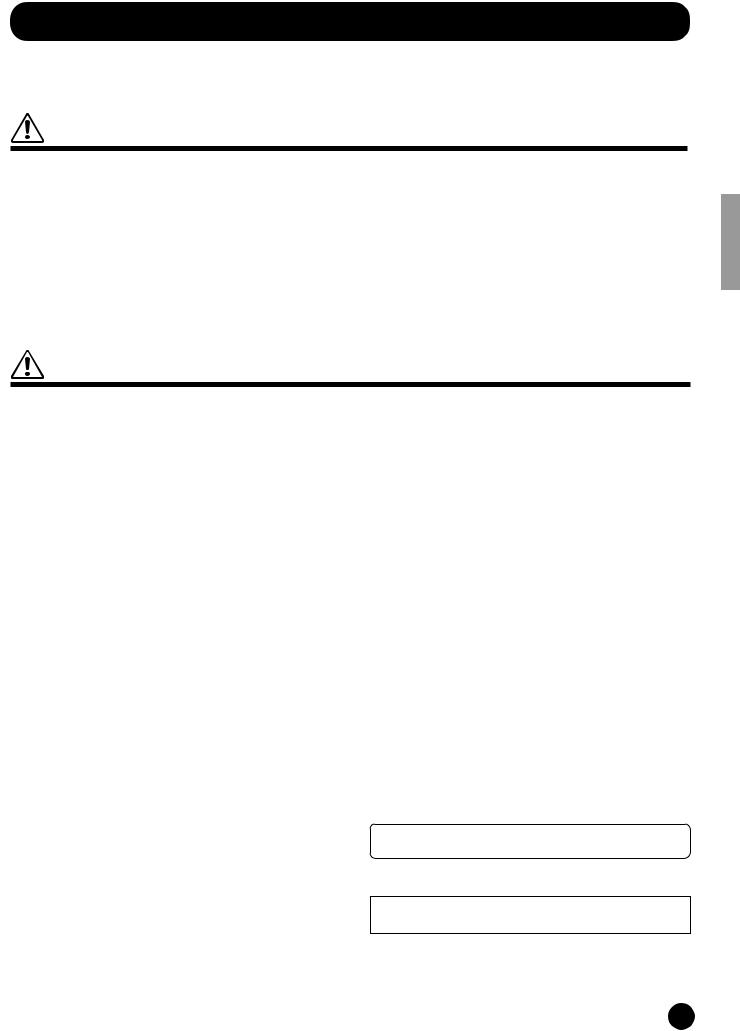
PRECAUTIONS
PLEASE READ CAREFULLY BEFORE PROCEEDING
* Please keep these precautions in a safe place for future reference.
WARNING
Always follow the basic precautions listed below to avoid the possibility of serious injury or even death from electrical shock, short-circuiting, damages, fire or other hazards. These precautions include, but are not limited to, the following:
•Do not open the instrument or attempt to disassemble the internal parts or modify them in any way. The instrument contains no user-serviceable parts. If it should appear to be malfunctioning, discontinue use immediately and have it inspected by qualified Yamaha service personnel.
•Do not expose the instrument to rain, use it near water or in damp or wet conditions, or place containers on it containing liquids which might spill into any openings.
•If the power cord or plug becomes frayed or damaged, or if there is a sudden loss of sound during use of the instrument, or if any unusual smells or smoke should appear to be caused by it, immediately turn off the power
switch, disconnect the electric plug from the outlet, and have the instrument inspected by qualified Yamaha service personnel.
•Only use the voltage specified as correct for the instrument. The required voltage is printed on the name plate of the instrument.
•Before cleaning the instrument, always remove the electric plug from the outlet. Never insert or remove an electric plug with wet hands.
•Check the electric plug periodically and remove any dirt or dust which may have accumulated on it.
CAUTION
Always follow the basic precautions listed below to avoid the possibility of physical injury to you or others, or damage to the instrument or other property. These precautions include, but are not limited to, the following:
•Do not place the power cord near heat sources such as heaters or radiators, and do not excessively bend or otherwise damage the cord, place heavy objects on it, or place it in a position where anyone could walk on, trip over, or roll anything over it.
•When removing the electric plug from the instrument or an outlet, always hold the plug itself and not the cord. Pulling by the cord can damage it.
•Do not connect the instrument to an electrical outlet using a multiple-con- nector. Doing so can result in lower sound quality, or possibly cause overheating in the outlet.
•Remove the electric plug from the outlet when the instrument is not to be used for extended periods of time, or during electrical storms.
•Before connecting the instrument to other electronic components, turn off the power for all components. Before turning the power on or off for all components, set all volume levels to minimum.
•Do not expose the instrument to excessive dust or vibrations, or extreme cold or heat (such as in direct sunlight, near a heater, or in a car during the day) to prevent the possibility of panel disfiguration or damage to the internal components.
•Do not use the instrument near other electrical products such as televisions, radios, or speakers, since this might cause interference which can affect proper operation of the other products.
•Do not place the instrument in an unstable position where it might accidentally fall over.
•Before moving the instrument, remove all connected cables.
•When cleaning the instrument, use a soft, dry cloth. Do not use paint thinners, solvents, cleaning fluids, or chemical-impregnated wiping cloths. Also, do not place vinyl, plastic or rubber objects on the instrument, since this might discolor the panel or keyboard.
•Do not rest your weight on, or place heavy objects on the instrument, and do not use excessive force on the buttons, switches or connectors.
•Take care that the key cover does not pinch your fingers, and do not insert a finger or hand in the key cover gap.
•Never insert or drop paper or metallic or other objects between the slits of the key cover and the keyboard. If this happens, immediately turn off the power and remove the electric plug from the outlet and have the instrument inspected by qualified Yamaha service personnel.
•Do not place the instrument against a wall (allow at least 3 cm/one-inch from the wall), since this can cause inadequate air circulation, and possibly result in the instrument overheating.
•Read carefully the attached documentation explaining the assembly process. Failure to assemble the instrument in the proper sequence might result in damage to the instrument or even injury.
•Do not operate the instrument for a long period of time at a high or uncomfortable volume level, since this can cause permanent hearing loss. If you experience any hearing loss or ringing in the ears, consult a physician.
■USING THE BENCH
•Do not play carelessly with or stand on the bench. Using it as a tool or stepladder or for any other purpose might result in accident or injury.
•Only one person should sit on the bench at a time, in order to prevent the possibility of accident or injury.
•If the bench screws become loose due to extensive long-term use, tighten them periodically using the included tool.
■SAVING USER DATA
•Save all data to an external device such as the Yamaha MIDI Data Filer MDF3, in order to help prevent the loss of important data due to a malfunction or user operating error.
Yamaha cannot be held responsible for damage caused by improper use or modifications to the instrument, or data that is lost or destroyed.
Always turn the power off when the instrument is not in use.
*The illustrations and LCD screens as shown in this owner’s manual are for instructional purposes only, and may be different from the ones on your instrument.
(1)B_EL/CL-3vari.
YDP-101 3
1
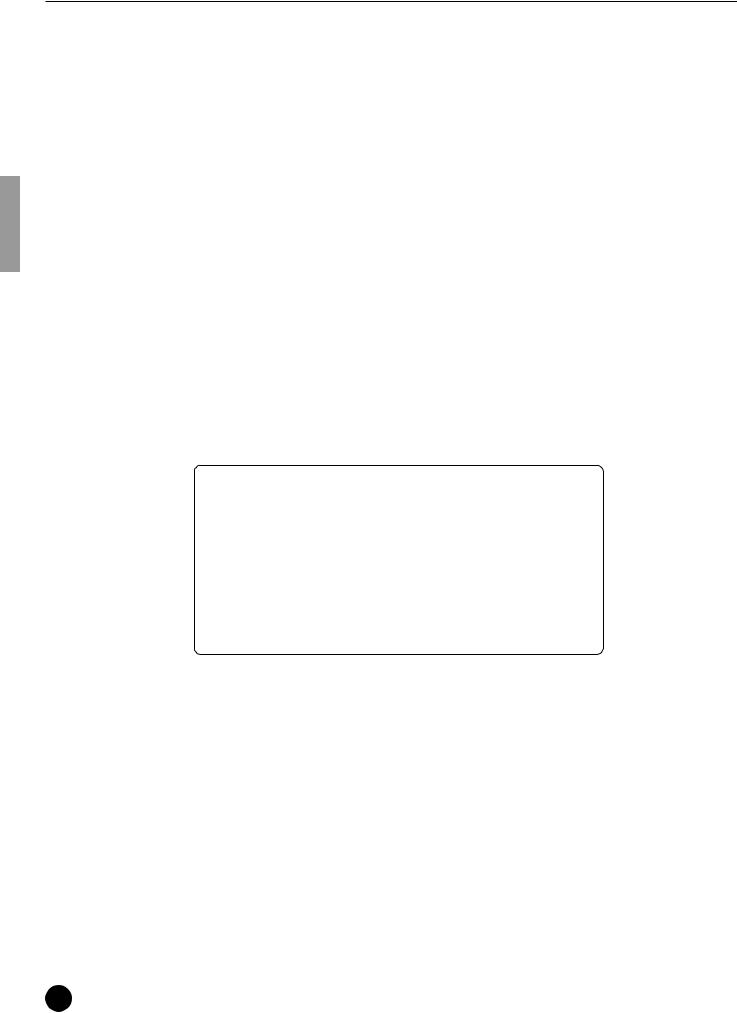
Introduction
Thank you for choosing a Yamaha YDP-101 Digital Piano. Your YDP-101 is a fine musical instrument that employs advanced Yamaha music technology. With the proper care, your YDP-101 will give you many years of musical pleasure.
●Stereo sampling of the acoustic piano voices offers unmatched realism and expressive power, while the AWM (Advanced Wave Memory) tone generator system offers rich, realistic reproductions of all other voices.
●Piano-like touch response — adjustable in 4 stages — provides extensive expressive control and outstanding playability.
●Dual mode allows 2 voices to be played simultaneously.
●Metronome feature with variable tempo facilitates practice.
●2-track digital recorder lets you record and play back anything you play on the keyboard.
●MIDI compatibility and a range of MIDI functions make the YDP-101 useful in a range of advanced MIDI music systems.
In order to make the most of your YDP-101’s performance potential and features, we urge you to read this Owner’s Manual thoroughly, and keep it in a safe place for later reference.
Included Accessories
●Owner’s Manual
●Bench
●Stereo Headphones
4 YDP-101
2

Contents
The Control Panel .......................................................... |
6 |
Key Cover & Music Stand .............................................. |
8 |
Connections ................................................................... |
9 |
Selecting & Playing Voices .......................................... |
10 |
Playing the Demonstration Tunes ................................ |
11 |
■ Voice Demo .............................................................. |
11 |
■ Piano Song .............................................................. |
12 |
■ Piano Song A-B Repeat .......................................... |
13 |
■ Piano Song Part Cancel ......................................... |
14 |
● Synchro Start ..................................................... |
14 |
● Left Pedal Start/Stop ......................................... |
14 |
The Dual Mode ............................................................ |
15 |
● Other Dual Mode Functions ............................... |
15 |
Reverb ........................................................................ |
16 |
● Adjusting Reverb Depth ..................................... |
16 |
The Pedals ................................................................... |
17 |
● Damper (Right) Pedal ........................................ |
17 |
● Sostenuto (Center) Pedal .................................. |
17 |
● Soft (Left) Pedal ................................................. |
17 |
Touch Sensitivity ......................................................... |
18 |
Transposition ............................................................... |
18 |
Tuning ......................................................................... |
19 |
● Tuning Up........................................................... |
19 |
● Tuning Down ...................................................... |
19 |
● To Restore Standard Pitch ................................. |
19 |
The Metronome & Tempo Control ................................ |
20 |
■ The Metronome ........................................................ |
20 |
● Metronome Time Signature ............................... |
20 |
● Metronome Volume Function ............................. |
20 |
■ Tempo Control ......................................................... |
20 |
Using the Recorder ...................................................... |
21 |
■ Recording ................................................................ |
21 |
● Changing the Initial Settings .............................. |
22 |
● Erasing a Single Track ....................................... |
22 |
■ Playback ................................................................... |
23 |
● Synchro Start ..................................................... |
23 |
● Left Pedal Start/Stop ......................................... |
23 |
The Function Mode ...................................................... |
24 |
● To Select a Function …...................................... 24 |
|
■ F1: Tuning ................................................................ |
25 |
■ F2: Scale .................................................................. |
25 |
F2.1: Scale ........................................................... |
25 |
F2.2: Base Note ................................................... |
25 |
■ F3: Dual Mode Functions ....................................... |
26 |
F3.1: Dual Balance ............................................... |
26 |
F3.2: Dual Detune ................................................ |
26 |
F3.3: 1st Voice Octave Shift ................................. |
26 |
F3.4: 2nd Voice Octave Shift ................................ |
26 |
F3.5: Reset ........................................................... |
26 |
■ F4: Left Pedal Mode ................................................ |
27 |
■ F5: Metronome Volume ........................................... |
27 |
■ F6: Piano Song Part Cancel Volume ...................... |
27 |
■ F7: MIDI Functions .................................................. |
28 |
● A Brief Introduction to MIDI ............................... |
28 |
F7.1: MIDI Transmit Channel Selection ................ |
28 |
F7.2: MIDI Receive Channel Selection ................ |
28 |
F7.3: Local Control ON/OFF ................................ |
29 |
F7.4: Program Change ON/OFF .......................... |
29 |
F7.5: Control Change ON/OFF ............................ |
30 |
F7.6: MIDI Transmit Transpose ............................. |
30 |
F7.7: Panel/Status Transmit .................................. |
30 |
F7.8: Bulk Data Dump .......................................... |
30 |
■ F8: Backup Functions ............................................. |
31 |
F8.1: Voice ............................................................ |
31 |
F8.2: MIDI ............................................................. |
31 |
F8.3: Tuning .......................................................... |
31 |
F8.4: Pedal ........................................................... |
31 |
Factory Preset Recall .................................................. |
32 |
Troubleshooting ........................................................... |
32 |
Options & Expander Modules ...................................... |
32 |
Demo and Piano Song List ................................................ |
33 |
Factory Setting List ............................................................ |
34 |
MIDI Data Format................................................................ |
35 |
MIDI Implementation Chart ............................................... |
39 |
Keyboard Stand Assembly ................................................ |
40 |
Specifications ..................................................................... |
46 |
YDP-101 5
3
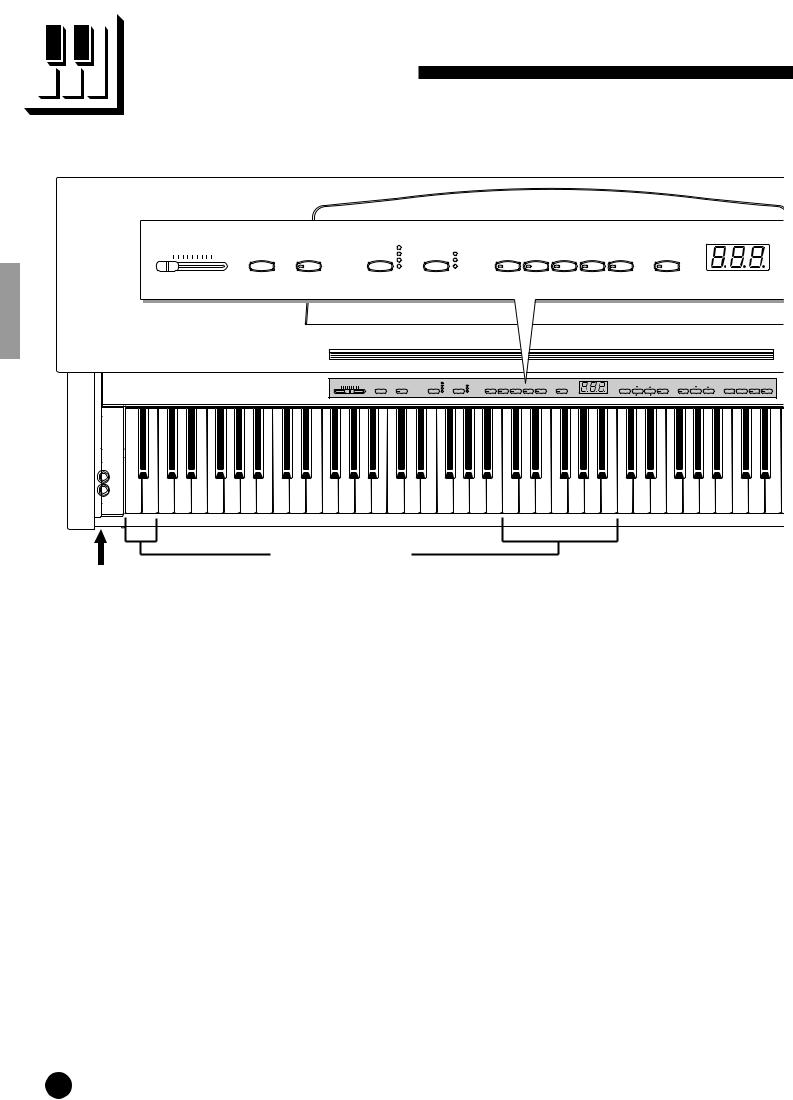
The Control Panel
|
MASTER VOLUME |
|
|
|
ROOM |
|
|
GRAND |
HARPSI- |
PIPE |
|
MIN |
DEMO |
TRANSPOSE |
REVERB |
HALL1 |
TOUCH |
HARD |
VARIATION |
||||
MAX |
HALL2 |
MEDIUM |
PIANO E.PIANO |
CHORD STRINGS |
ORGAN |
||||||
|
|
|
|
|
STAGE |
|
SOFT |
|
|
|
|
|
2 |
3 |
4 |
5 |
|
6 |
|
|
7 |
|
|
|
MASTER VOLUME |
|
|
|
HALL 1 |
|
HARD |
GRAND |
HARPSI- |
PIPE |
|
METRO- |
|
|
|
SONG |
START/ |
|
|
TRACK |
MIN |
MAX |
DEMO |
TRANSPOSE |
REVERB |
HALL 2 |
TOUCH |
MEDIUM |
PIANO |
E. PIANO CHORD |
STRINGS ORGAN |
VARIATION |
NOME |
TEMPO |
FUNCTION |
SONG |
SELECT |
STOP |
REC |
1 |
2 |
|
|
|
|
|
STAGE |
|
SOFT |
|
|
|
|
|
|
|
|
|
|
|
|
|
|
|
|
|
|
|
|
|
|
|
|
|
|
FUNCTION |
|
|
–/NO +/YES |
|
|
|
|
A-1 B-1 C0 D0 E0 F0 G0 A0 B0 C1 D1 E1 F1 G1 A1 B1 C2 D2 E2 F2 G2 A2 B2 C3 D3 E3 F3 G3 A3 B3 C4 D4 E4 F4 G4 A4 B4 C5 D5 E5 |
||||||||||||||||||||
Tuning keys (See page 19)
PHONES Jacks (Bottom panel) (See page 9)
1[POWER] Switch
Press the [POWER] switch once to turn the power ON, a second time to turn the power OFF. When the power is initially turned ON, a voice selector LED will light, and the power indicator located below the left end of the keyboard will light.
2[MASTER VOLUME] Control
The [MASTER VOLUME] control adjusts the volume (level) of sound produced by the YDP-101’s internal stereo sound system. The [MASTER VOLUME] control also adjusts headphone volume when a pair of headphones is plugged into the PHONES jack (page 9).
3[DEMO] Button
Activates the demo playback mode in which you can select playback of different demonstration sequences for each of the YDP-101’s voices. See page 11 for details.
6 YDP-101
4[TRANSPOSE] Button
The [TRANSPOSE] button allows access to the YDP-101’s TRANSPOSE function (to shift the pitch of the entire keyboard up or down in semitone intervals).
5[REVERB] Button
The [REVERB] button selects a number of digital reverb effects that you can use for extra depth and expressive power. See page 16 for details.
6[TOUCH] Button
The [TOUCH] button makes it easy to adjust the touch response of the YDP-101 to match your playing style. See page 18 for details.
7Voice Selectors & [VARIATION] Button
Simply press any of the voice selectors to select the corresponding voice. The voice selector LED will light to indicate which voice is currently selected. Press the [VARIATION] button so that its indicator lights to select a variation of the currently selected voice.
4
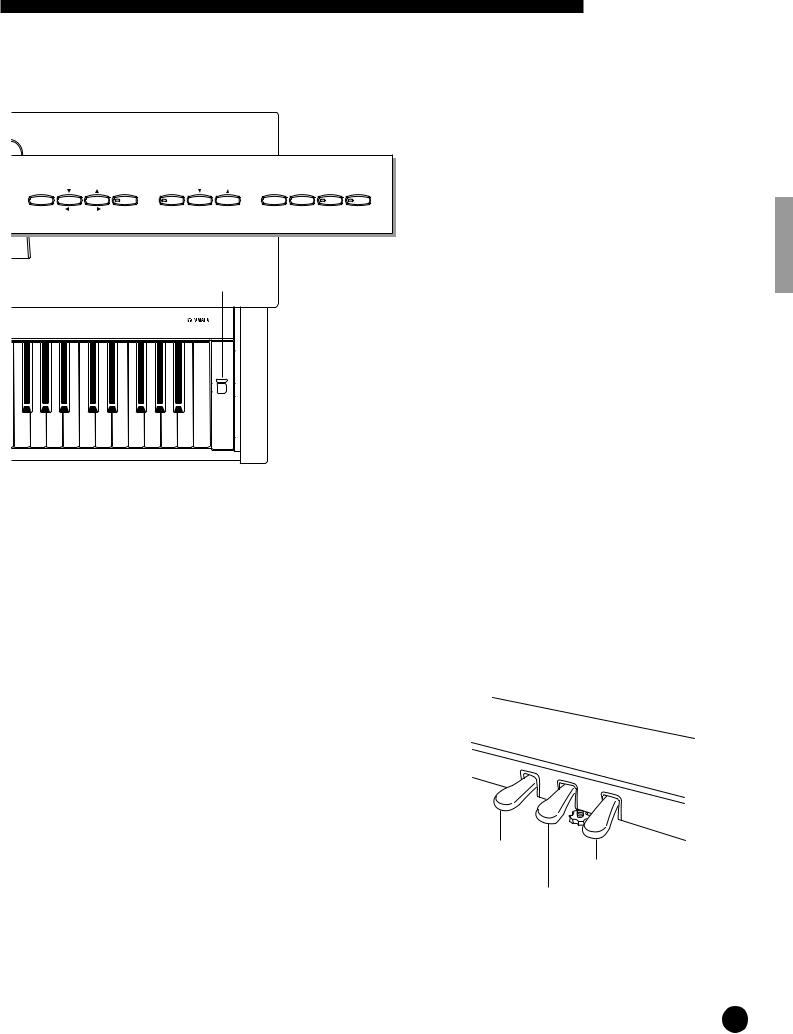
The Control Panel
METRO- |
|
|
|
|
SONG |
START/ |
|
|
TRACK |
NOME |
TEMPO |
FUNCTION |
SONG |
SELECT |
STOP |
REC |
1 |
2 |
|
|
FUNCTION |
|
|
–/NO |
+/YES |
|
|
|
|
8 |
9 0 |
! |
@ |
# |
$ |
|
|
|
1 |
|
|
|
|
DIGITAL PIANO YDP-101 |
|
|
|
|
|
|
POWER |
|
|
F5 G5 A5 B5 C6 D6 E6 F6 G6 A6 B6 C7 |
|
|
|
||
There is also a dual mode in which two voices can be played simultaneously across the full range of the keyboard (see page 15 for details).
8[METRONOME] Button
Turns the metronome sound on and off. The [TEMPO ▼/▲] buttons, below, are used to set the tempo of the metronome sound. The [–/NO] and [+/ YES] buttons are used to change the time signature (beat) of the metronome if used while the [METRONOME] button is held — page 20.
9[TEMPO ▼/▲] (FUNCTION </>) Buttons
These buttons adjust the tempo of the metronome function as well as the playback tempo of the recorder function. The tempo range is from 32 to 280 beats per minute — page 20. These same buttons are also used to select functions — page 24.
0[FUNCTION] Button
This button accesses a range of utility functions
— including the MIDI functions — that significantly enhance versatility and playability. See page 24 for details.
![SONG] Button
This button enters the Piano Song Mode. While in this mode you can use the [SONG SELECT ▼/ ▲] buttons to select from 50 songs.
@[SONG SELECT ▼/▲] (–/NO, +/YES) Buttons
These buttons select a piano song number for playback, and are also used to adjust a range of other parameters (i.e. their “–/NO” and “+/YES” functions).
#[START/STOP] and [REC] Buttons
These buttons control the YDP-101’s recorder, letting you record and play back just about anything you play on the keyboard.
$TRACK [1] and [2] Buttons
The YDP-101 has a 2-track recorder, and these buttons are used to select the track(s) to be recorded or played back. See page 21 for details.
%Pedals
The soft (left), sostenuto (center) and damper (right) pedals provide a range of expressive control capabilities similar to the pedal functions on an acoustic piano. The left pedal can also be assigned to the song start/stop operation. See page 17 for details.
%
Soft pedal
Damper pedal
Sostenuto pedal
YDP-101 7
5
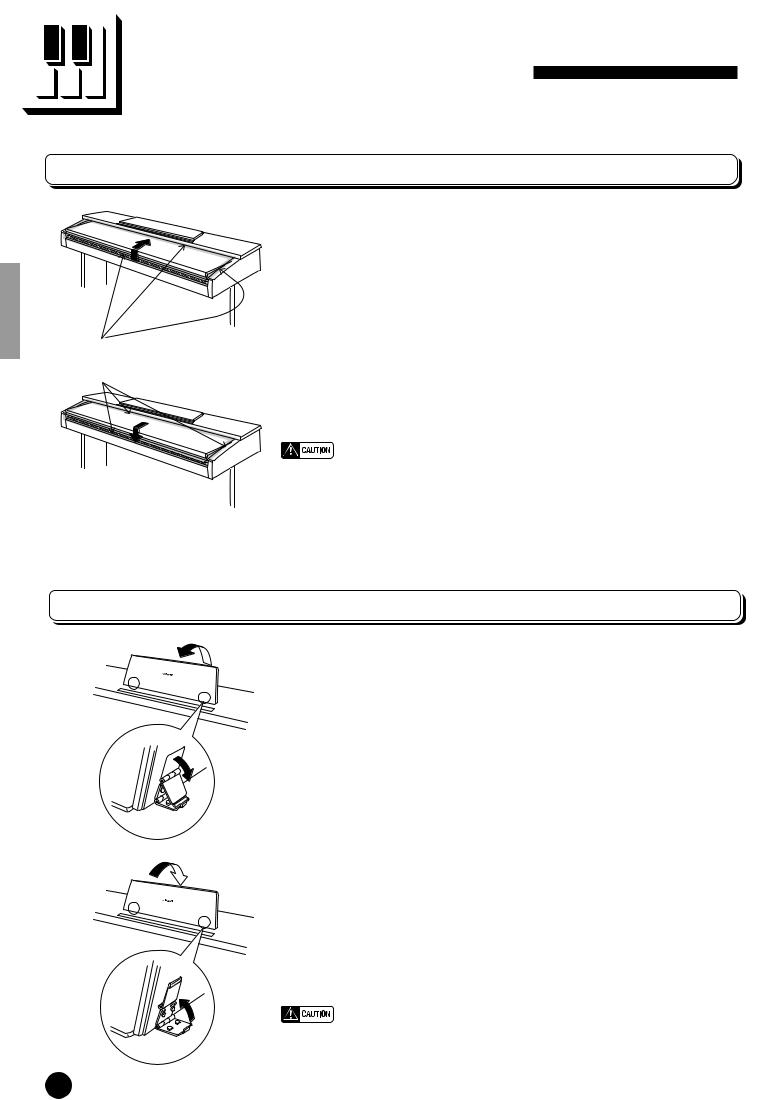
Key Cover & Music Stand
Key Cover
Be careful to avoid catching your fingers when opening or closing the cover.
To open the key cover:
ZLift the cover slightly (not too much).
XSlide the cover open.
To close the key cover:
ZSlide the cover toward you.
XGently lower the cover over the keys.
• Hold the cover with both hands when moving it, and do not release it until it is fully opened or closed. Be careful to avoid catching fingers (yours or others) between the cover and main unit.
•Do not place objects on top of the key cover. Small objects placed on the key cover may fall inside the main unit when the cover is opened and may not be able to be removed. This could cause electric shock, short circuit, fire or other serious damage to the instrument.
Music Stand
To raise the music stand:
ZPull the stand up and toward yourself as far as it will go.
XFlip down the two metal supports at the left and the right on the rear of the music stand.
CLower the music stand so that it rests on the metal supports.
To lower the music stand:
ZPull the music stand toward yourself as far as it will go.
XRaise the two metal supports (at the rear of the stand).
CGently lower the music stand backward until it is all the way down.
• Do not try to use the music stand in a half-raised position.
When lowering the stand, do not release your hands from the music stand until it is all the way down.
8 YDP-101
6
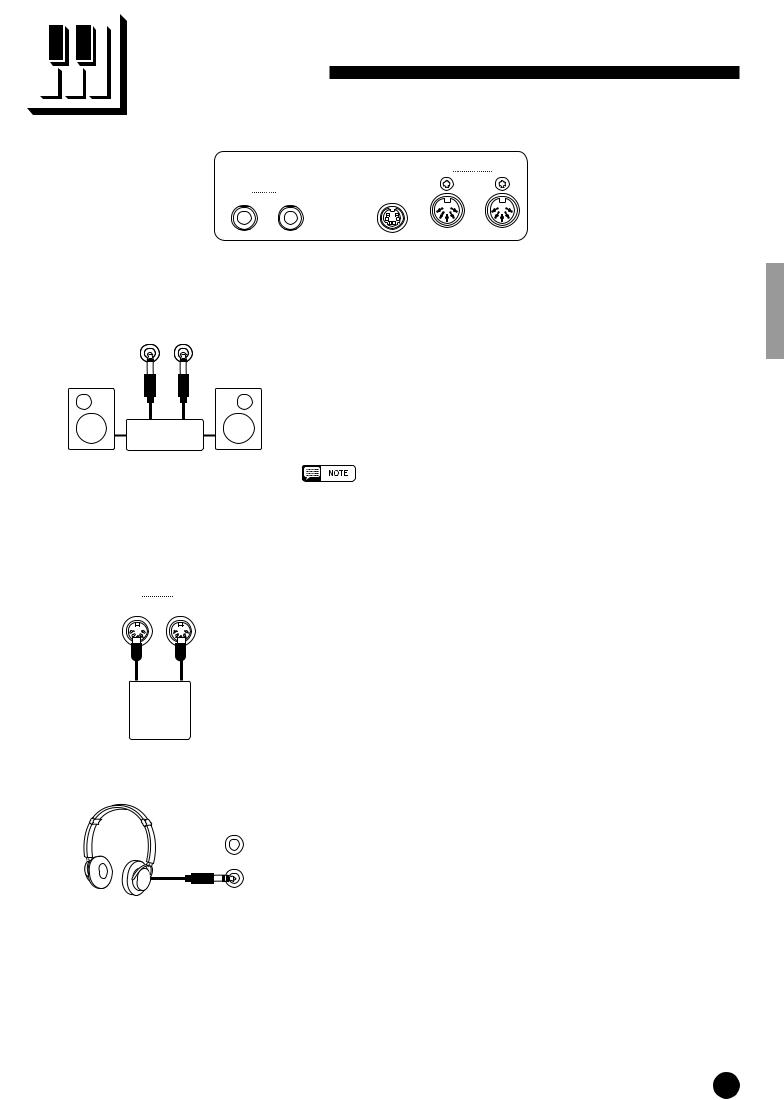
Connections
AUX OUT
R 









 L/L+R
L/L+R
Stereo System
|
|
|
MIDI |
|
|
IN |
OUT |
|
AUX OUT |
|
|
R |
L/L+R |
PEDAL |
|
1 2 3
1AUX OUT L/L+R and R Jacks
The AUX OUT L/L+R and R jacks deliver the output of the YDP-101 for connection to an instrument amplifier, mixing console, PA system, or recording equipment. If you will be connecting the YDP-101 to a monaural sound system, use only the L/L+R jack. When a plug is inserted into the L/L+R jack only, the leftand right-channel signals are combined and delivered via the L/L+R jack so you don’t lose any of the YDP-101’s sound.
• The AUX OUT jack signal is not controlled by the YDP-101’s volume control.
Use the volume control on the external audio equipment to adjust the level.
2PEDAL Jack
This terminal is for connecting the pedal cord from the pedal box (refer to the “Keyboard Stand Assembly” on pages 40-45).
|
MIDI |
IN |
OUT |
|
3MIDI IN and OUT Connectors |
|
The MIDI IN connector receives MIDI data from an external MIDI |
|
device (such as a sequencer or MIDI instrument) which can be used to |
|
control the YDP-101. The MIDI OUT connector transmits MIDI data |
Sequencer |
generated by the YDP-101 (e.g. note and velocity data produced by |
|
playing the YDP-101 keyboard). |
|
More details on MIDI are given in “MIDI Functions” on page 28. |
● PHONES Jacks (Bottom Panel)
Two sets of standard stereo headphones can be plugged in here for private practice or late-night playing. The internal speaker system is automatically shut off when a pair of headphones is plugged into either of the PHONES jacks.
YDP-101 9
7
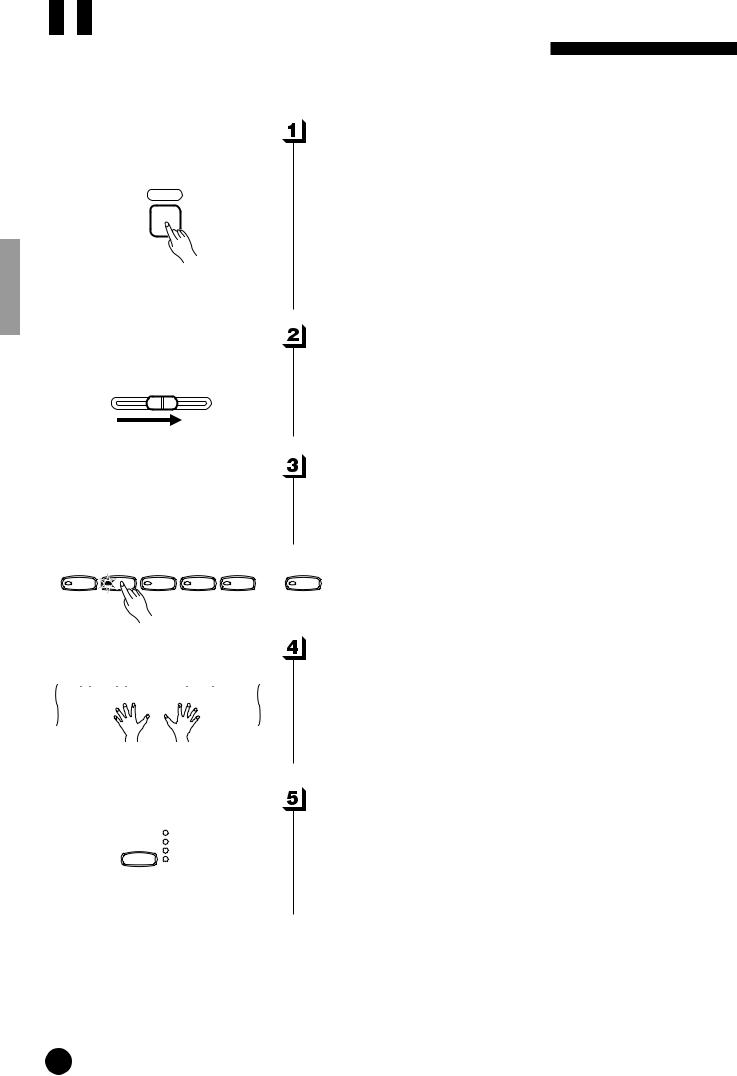
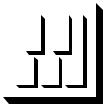 Selecting & Playing Voices
Selecting & Playing Voices
Turn Power On...................................................................................................
POWER
MASTER VOLUME
MIN |
|
|
|
|
|
|
|
|
|
|
|
|
|
|
|
|
|
MAX |
|
GRAND |
|
|
|
|
|
|
HARPSI- |
|
PIPE |
|
||||||||||||
|
PIANO |
|
E.PIANO CHORD STRINGS |
|
ORGAN |
|
|||||||||||||||||
|
|
|
|
|
|
|
|
|
|
|
|
|
|
|
|
|
|
|
|
|
|
|
|
|
|
|
|
|
|
|
|
|
|
|
|
|
|
|
|
|
|
|
|
|
|
|
|
|
|
|
|
|
|
|
|
|
|
|
|
|
|
|
|
|
|
|
|
|
|
|
|
ROOM
HALL1
REVERB
HALL2
STAGE
After making sure that the YDP-101’s AC cord is properly plugged into the YDP-101 itself and plugged into a convenient AC wall outlet, press the [POWER] switch located to the right of the keyboard to turn the power ON. In some areas a plug adaptor may be provided to match the pin configuration of the AC wall outlets in your area.
When the power is turned ON, one of the voice selector LEDs will light, and the power indicator located below the left end of the keyboard will light.
Set the Volume ..................................................................................................
Initially set the [MASTER VOLUME] control about half way between the “MIN” and “MAX” settings. Then, when you start playing, re-adjust the [MASTER VOLUME] control for the most comfortable listening level.
Select a Voice .....................................................................................................
Select the desired voice by pressing one of the voice selectors. Use the [VARIATION] button to select a variation of the current voice, as required.
VARIATION
Play................................................................................................................................
The YDP-101 also offers keyboard touch response, so the volume and timbre of notes played can be controlled according to how “hard” you play the keys. The amount of variation available depends on the selected voice.
Add Reverb As Required .......................................................................
You can add or change reverb as desired by using the [REVERB] button (page 16).
10 YDP-101
8
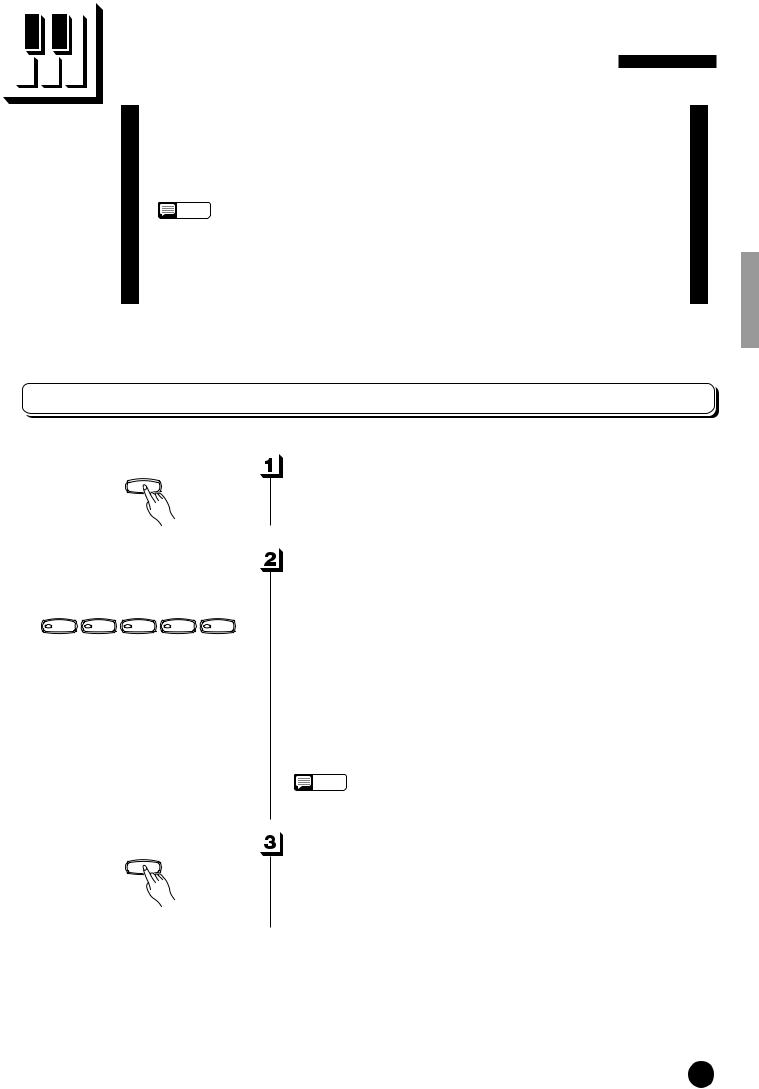
Playing the Demonstration Tunes
Demonstration tunes are provided that effectively demonstrate each of the YDP-101’s voices. There are also 50 piano songs that you can play individually, all in sequence, or in random order. Here’s how you can select and play the demo tunes.
NOTE • The demo or piano song mode cannot be engaged while the recorder (page 21) is in use.
•No MIDI reception occurs in the demo/piano song mode.
•The demo/piano song data is not transmitted via the MIDI connectors.
*See page 33 for a complete listing of the demo tunes and piano songs.
Voice Demo
DEMO |
Engage the Demo Mode ......................................................................... |
|
Press the [DEMO] button to engage the demo mode — the voice |
|
selector indicators will flash in sequence. |
|
Play a Voice Demo ......................................................................................... |
GRAND |
HARPSI- |
PIPE |
PIANO |
E.PIANO CHORD |
STRINGS ORGAN |
DEMO
Press one of the voice selectors to start playback of all songs starting from the corresponding voice demo tune — featuring the voice normally selected by that voice selector button. (If you press the [START/ STOP] button instead of a voice selector button, the GRAND PIANO demo tune will begin playback.) The indicator of the selected voice selector button will flash during playback, and “- - -” will appear on the LED display. You can start playback of any other voice demo tune during playback by simply pressing the corresponding voice selector. You can stop playback at any time by pressing the [START/STOP] button or the voice selector of the currently playing demo.
NOTE • Use the [MASTER VOLUME] control to adjust the volume.
Exit From the Demo Mode....................................................................
Press the [DEMO] button to exit from the demo mode and return to the normal play mode.
YDP-101 11
9
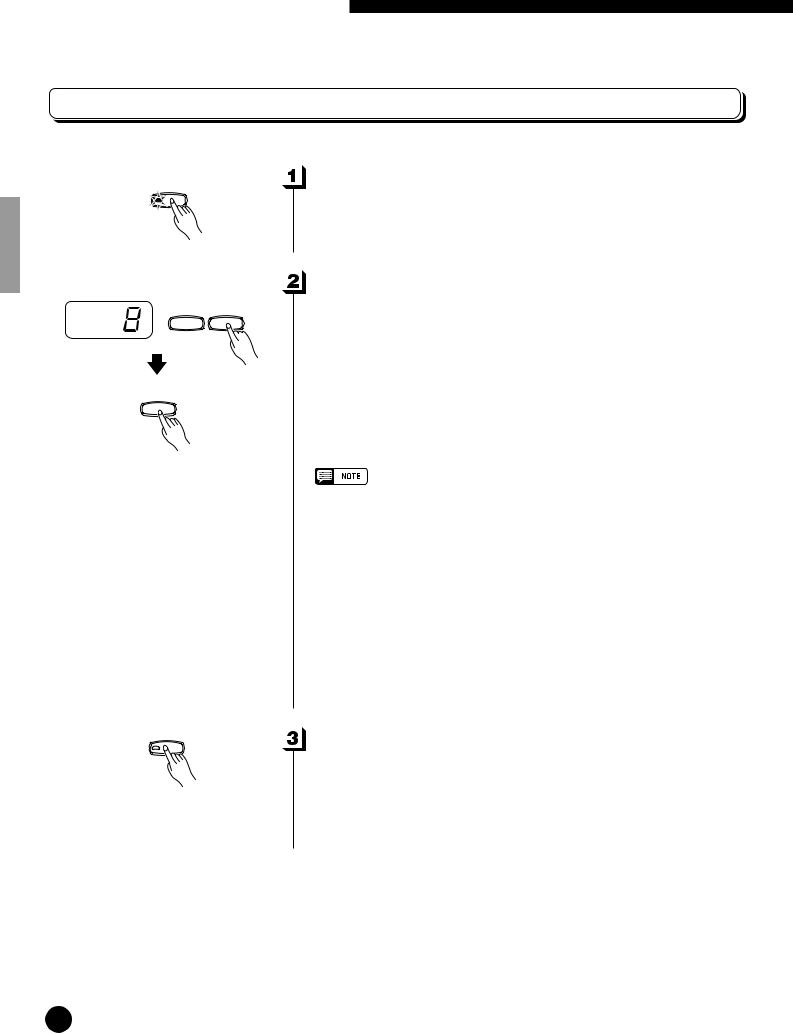
Playing the Demonstration Tunes
Piano Song
SONG
SONG
 SELECT
SELECT 
–/NO +/YES
START/
STOP
SONG
Engage the Piano Song Mode .........................................................
Press the [SONG] button to engage the piano song mode — the [SONG], [1] and [2] indicators will light.
Play a Piano Song .........................................................................................
To play any of the 50 piano songs provided, use the [SONG SELECT ▼/▲] buttons to select the number of the tune you want to play (the number will appear on the LED display), then press the [START/ STOP] button. Playback will stop automatically when playback of the selected piano song has finished.
Select “ALL” instead of a number to play all piano songs in sequence, or select “rnd” to continuously play all piano songs in random order. Press the [START/STOP] button to stop playback.
• Use the [MASTER VOLUME] control to adjust the volume.
•You can use the [TEMPO ▼/▲] buttons to adjust the playback tempo as required. This produces a relative tempo variation, with a range from “-50” through “- - -” to “50” at maximum; the range will differ depending on the selected song.
•The default tempo “- - -” is automatically selected whenever a new piano song is selected, or playback of a new piano song begins during “ALL” or “rnd” playback.
•You can play the keyboard along with the piano song playback. The voice playing on the keyboard can be changed.
•You can change the Reverb type that is applied to the voice you play on the keyboard and for the piano song playback. You can change the Touch sensitivity that is applied to the voice you play on the keyboard. When a new piano song is selected or a new piano song is automatically started in continuous play, the HALL 1 reverb type will automatically be selected.
Exit From the Piano Song Mode....................................................
Press the [SONG] button to exit from the piano song mode, the indicator will go off, and return to the normal play mode.
12 YDP-101
10
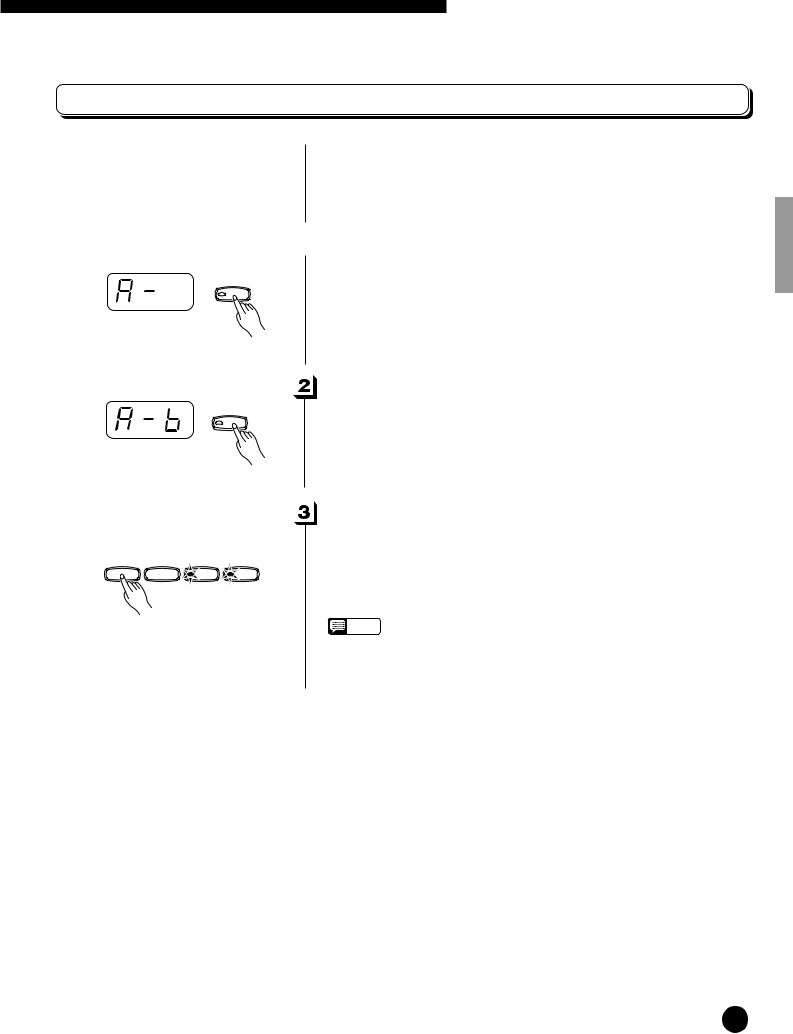
Playing the Demonstration Tunes
Piano Song A-B Repeat
FUNCTION
FUNCTION
START/ |
|
|
TRACK |
STOP |
REC |
1 |
2 |
The A-B Repeat function can be used to continuously repeat a specified phrase within a piano song. Combined with the Part Cancel function described below, this provides an excellent way to practice difficult phrases.
 Specify the Beginning (A) of the Phrase ..............................
Specify the Beginning (A) of the Phrase ..............................
Select and play a piano song, then press the [FUNCTION] button at the beginning of the phrase you want to repeat. This sets the “A” point (“A-” will appear on the display).
To set the “A” point at the very beginning of the song, press the [FUNCTION] button before starting playback.
Specify the End (B) of the Phrase ...............................................
Press the [FUNCTION] button a second time at the end of the phrase. This sets the “B” point (“A-b” will appear on the display). At this point repeat playback will begin between the specified A and B points.
Stop Playback ....................................................................................................
Press the [START/STOP] button to stop playback while retaining the specified A and B points. A-B repeat playback will resume if the [START/STOP] button is then pressed again.
To cancel the A and B points press the [FUNCTION] button once.
NOTE • The A and B points are automatically canceled when a new song is selected.
• The A-B Repeat function cannot be used during “ALL” or “rnd” playback.
YDP-101 13
11
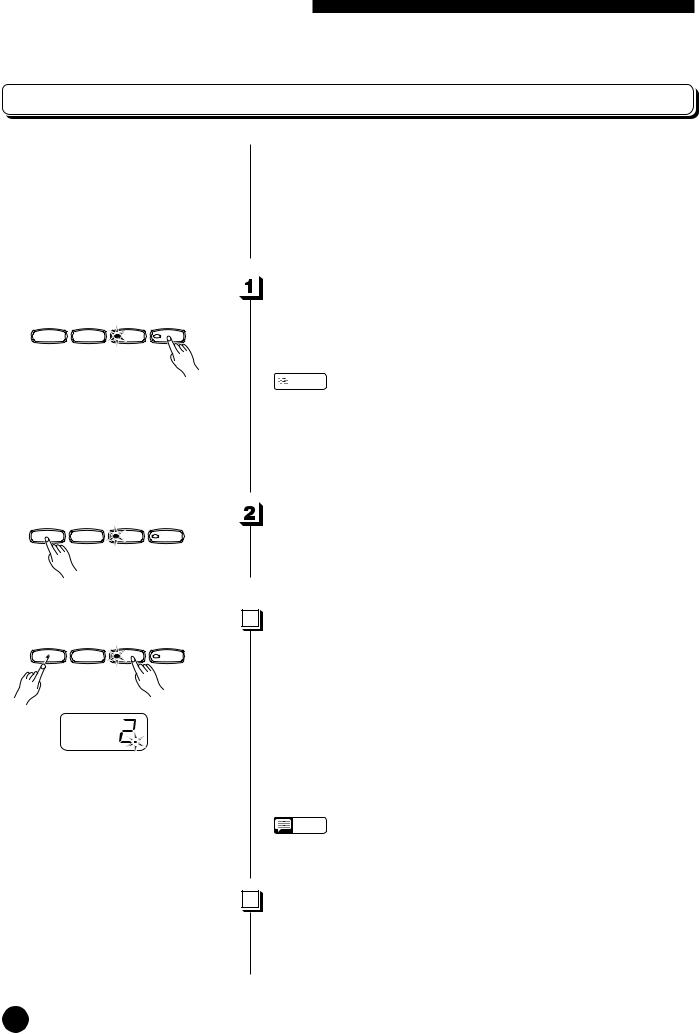
Playing the Demonstration Tunes
Piano Song Part Cancel
|
START/ |
|
|
TRACK |
|
|
|
||
|
STOP |
REC |
1 |
2 |
START/ |
|
|
TRACK |
STOP |
REC |
1 |
2 |
START/ |
|
|
TRACK |
STOP |
REC |
1 |
2 |
The 50 piano songs have separate leftand right-hand parts that can be turned on and off as required so you can practice the corresponding part on the keyboard. The right-hand part is played by the recorder’s [1] track, and the left-hand part is played by recorder’s [2] track. (Some of the songs are arrangements for four-hands, tracks [1] and [2] correspond to primo and secondo parts of the arrangement.)
Turn the Desired Part Off.......................................................................
Press the TRACK [1] or [2] button to turn the corresponding part off
— the corresponding indicator will go out (these buttons alternately toggle the corresponding part on and off).
 NOTE • The parts can be turned on or off even during playback.
NOTE • The parts can be turned on or off even during playback.
•The Piano Song Part Cancel function cannot be used during “ALL” or “rnd” playback.
•The “Piano Song Part Cancel Volume” function described on page 27 can be used to set the canceled part so that it plays at a volume from “0” (no sound) to “20”. The default setting is “5”.
•Both parts are automatically turned ON whenever a new song is selected.
Start/Stop Playback .....................................................................................
Press the [START/STOP] button to start and stop playback as required.
Synchro Start .....................................................................................................
When the Synchro Start function is engaged, playback of the selected piano song will begin automatically as soon as you start playing on the keyboard.
To engage the Synchro Start function press the [START/STOP] button while holding the part button corresponding to the part which is ON. A dot will appear in the lower right corner of the display. (Repeat the previous operation to disengage the Syncro Start function.)
Playback will then start as soon as you begin playing on the keyboard.
NOTE • If you hold a track button which is OFF while pressing the [START/STOP] button, that track will be turned ON and the Synchro Start mode will be engaged.
Left Pedal Start/Stop ..................................................................................
The left pedal can be assigned to start and stop piano song playback via the “Left Pedal Mode” function described on page 27.
14 YDP-101
12

The Dual Mode
The dual mode makes it possible to play two voices simultaneously across the entire range of the keyboard.
HARPSI- |
PIPE |
PIANO CHORD STRINGS |
ORGA |
Voice numbering priority |
|
|
|
|
|||||
1 |
2 |
3 |
4 |
5 |
|||||
|
|
|
|
|
|
|
|
|
|
GRAND |
E.PIANO |
HARPSI- |
STRINGS |
PIPE |
|||||
PIANO |
CHORD |
ORGAN |
|||||||
To activate the dual mode simply press two voice selectors at the same time (or press one voice selector while holding another). The voice indicators of both selected voices will light when the dual mode is active. To return to the normal single-voice play mode, press any single voice selector.
According to the voice numbering priority as shown in the diagram on the left, lower valued voice numbers will be designated as the 1st Voice (the other voice will be designated as the 2nd Voice).
The [STRINGS] [VARIATION] voice has a slow attack. This voice can sometimes be used with another voice in the Dual Mode to produce a better “blend”.
NOTE • The [VARIATION] button indicator will light if the variation is engaged for either or both of the dual-mode voices. While the dual mode is engaged the [VARIATION] button can be used to turn the variation for both voices on or off. To use the variation for only one of the voices the setting must be made prior to engaging the dual mode.
•[REVERB] in the Dual Mode
The reverb type assigned to the 1st Voice will take priority over the other.
(If the reverb is set to OFF, the 2nd Voice’s reverb type will be in affect.) Reverb depth setting via the panel controls (i.e. pressing the [-/NO] or [+/
YES] buttons while holding the [REVERB] button — see page 16) will be applied to the 1st Voice only.
Other Dual Mode Functions ...............................................................
The YDP-101 Function mode provides access to a number of other dual-mode functions, listed below. See the corresponding pages for details.
• |
Dual Balance ................................................. |
26 |
• |
Dual Detune .................................................. |
26 |
• |
1st Voice Octave Shift ................................... |
26 |
• |
2nd Voice Octave Shift .................................. |
26 |
• |
Reset ............................................................. |
26 |
YDP-101 15
13
